Abstract
The cultural characteristics, biochemical activity, and cellular fatty acid composition of Pseudomonas diminuta and Pseudomonas vesiculare provided means for differentiation of these closely related species. Broth cultures of P. diminuta showed turbid growth and a distinct surface pellicle after 24 h at 35 C. P. vesiculare had no pellicle, and only light, diffuse growth was observed. All strains of P. vesiculare oxidized maltose and hydrolyzed esculin to varying degrees; P. diminuta was negative in these tests. The cellular fatty acids of these two species were similar, except that P. diminuta possessed a C19 cyclopropane acid which was not detected in P. vesiculare.
Full text
PDF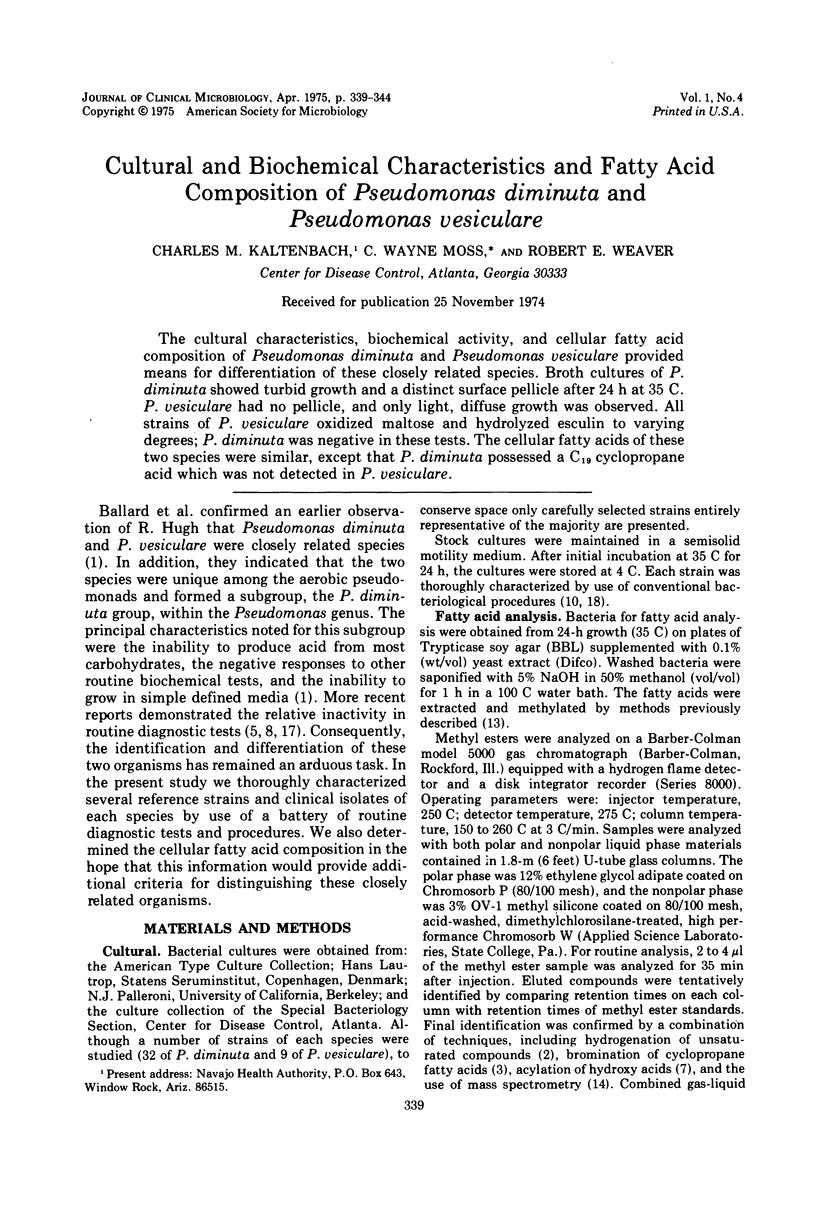
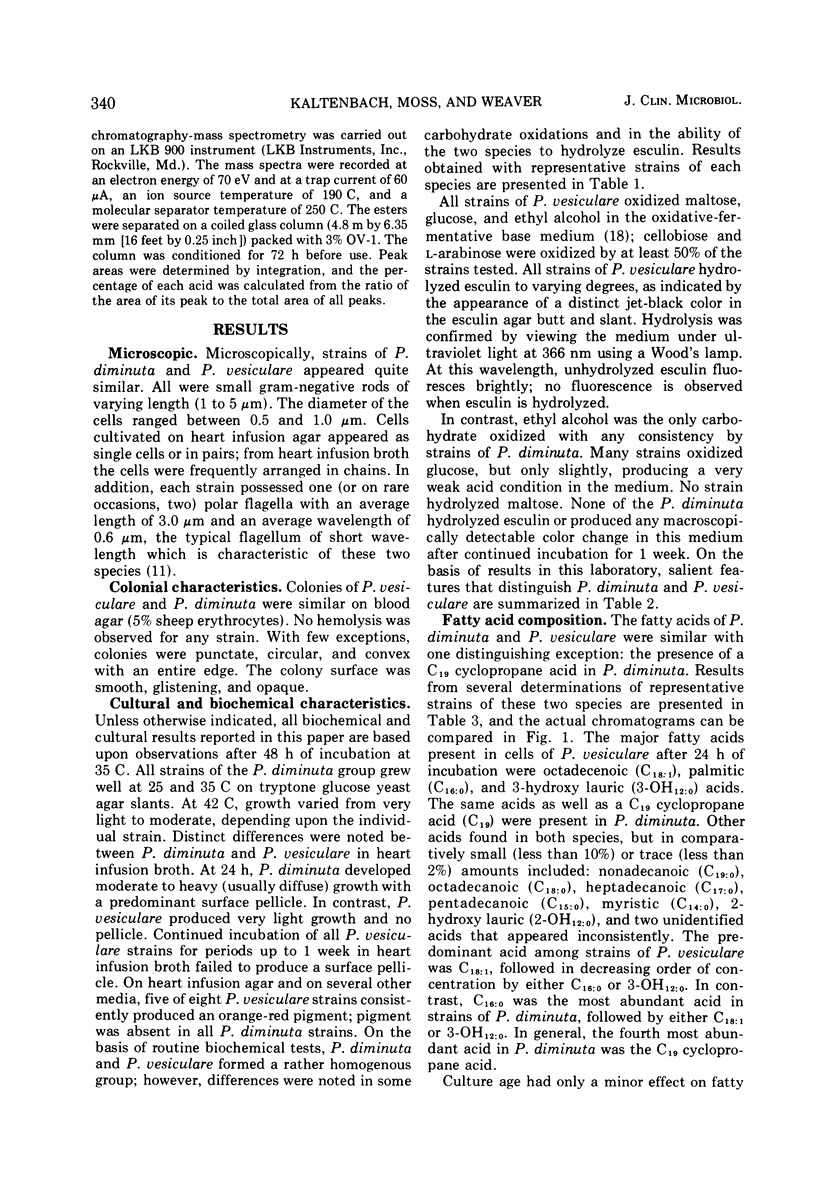
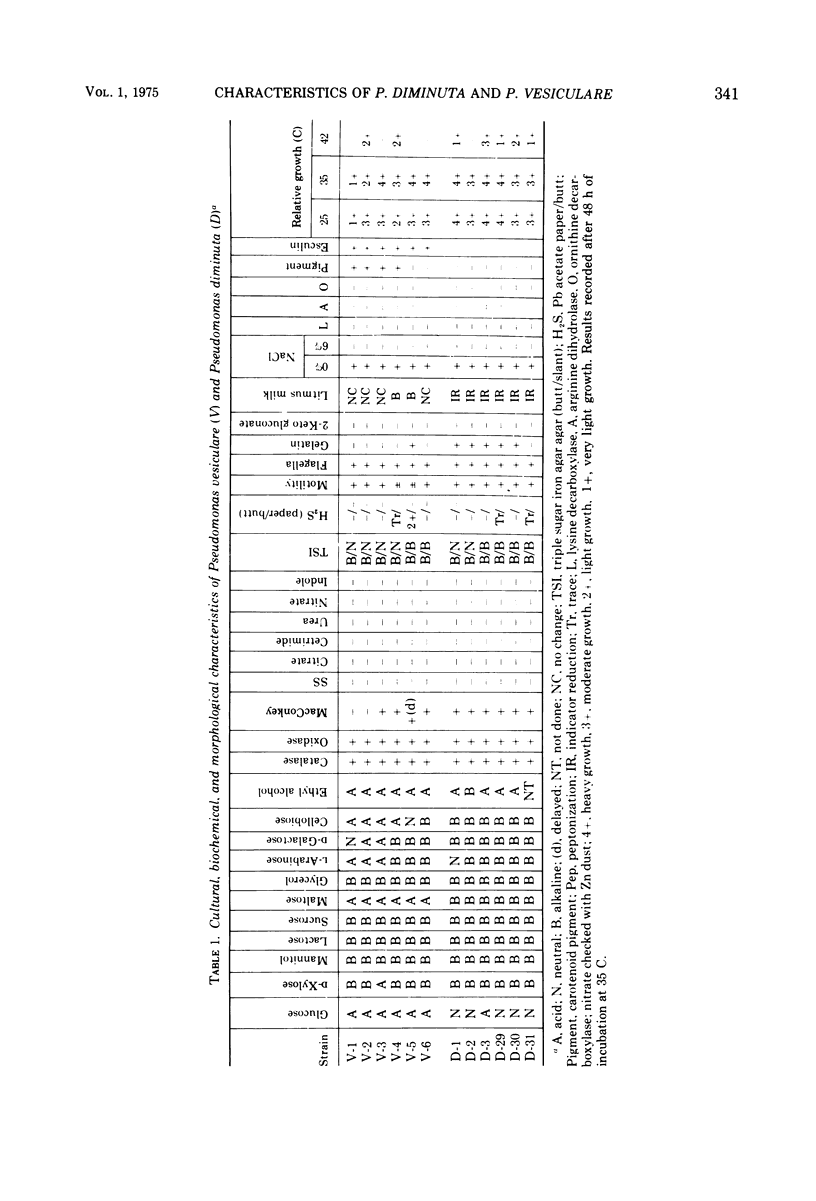
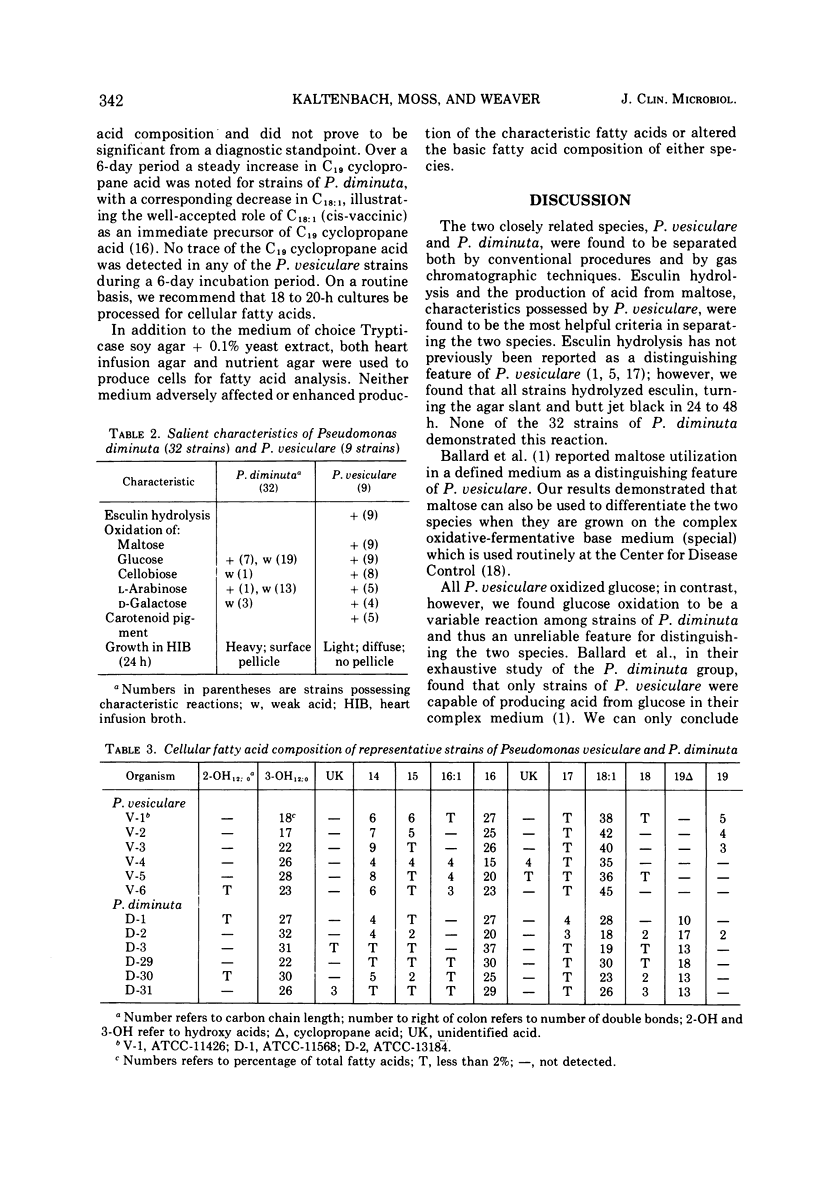
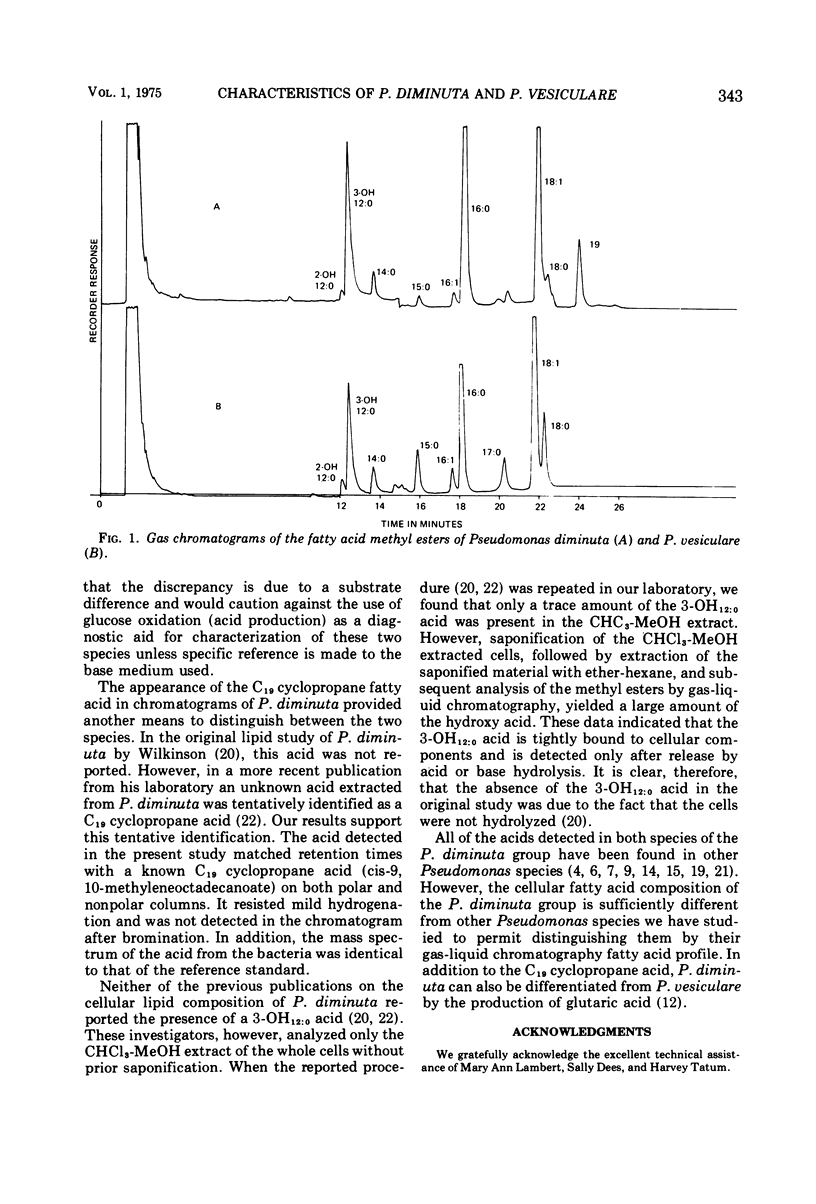
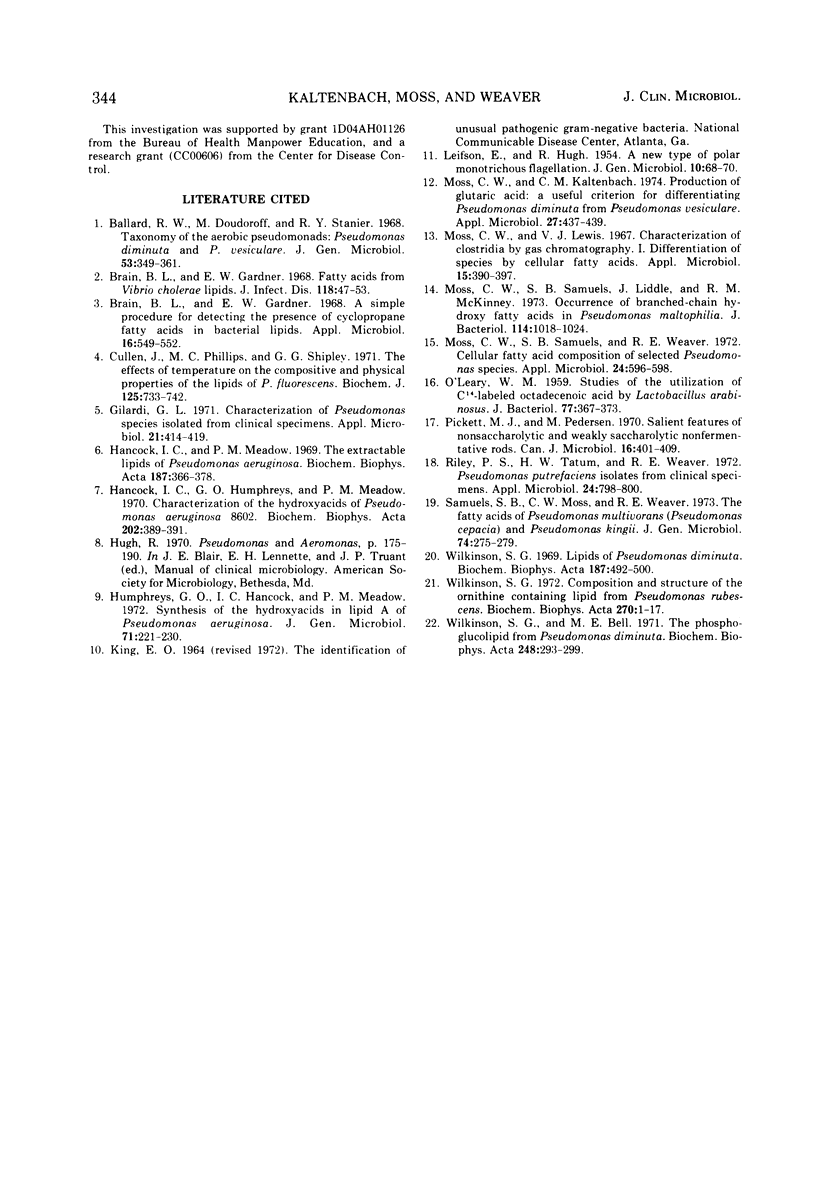
Selected References
These references are in PubMed. This may not be the complete list of references from this article.
- Ballard R. W., Doudoroff M., Stanier R. Y., Mandel M. Taxonomy of the aerobic psuedomonads: Pseudomonas diminuta and P. vesiculare. J Gen Microbiol. 1968 Oct;53(3):349–361. doi: 10.1099/00221287-53-3-349. [DOI] [PubMed] [Google Scholar]
- Brian B. L., Gardner E. W. A simple procedure for detecting the presence of cyclopropane fatty acids in bacterial lipids. Appl Microbiol. 1968 Apr;16(4):549–552. doi: 10.1128/am.16.4.549-552.1968. [DOI] [PMC free article] [PubMed] [Google Scholar]
- Brian B. L., Gardner E. W. Fatty acids from Vibrio cholerae lipids. J Infect Dis. 1968 Feb;118(1):47–53. doi: 10.1093/infdis/118.1.47. [DOI] [PubMed] [Google Scholar]
- Cullen J., Phillips M. C., Shipley G. G. The effects of temperature on the composition and physical properties of the lipids of Pseudomonas fluorescens. Biochem J. 1971 Dec;125(3):733–742. doi: 10.1042/bj1250733. [DOI] [PMC free article] [PubMed] [Google Scholar]
- Gilardi G. L. Characterization of Pseudomonas species isolated from clinical specimens. Appl Microbiol. 1971 Mar;21(3):414–419. doi: 10.1128/am.21.3.414-419.1971. [DOI] [PMC free article] [PubMed] [Google Scholar]
- Hancock I. C., Humphreys G. O., Meadow P. M. Characterisation of the hydroxy acids of Pseudomonas aeruginosa 8602. Biochim Biophys Acta. 1970 Mar 10;202(2):389–391. doi: 10.1016/0005-2760(70)90204-3. [DOI] [PubMed] [Google Scholar]
- Hancock I. C., Meadow P. M. The extractable lipids of Pseudomonas aeruginosa. Biochim Biophys Acta. 1969 Oct 28;187(3):366–379. doi: 10.1016/0005-2760(69)90010-1. [DOI] [PubMed] [Google Scholar]
- Humphreys G. O., Hancock I. C., Meadow P. M. Synthesis of the hydroxyacids in lipid A of Pseudomonas aeruginosa. J Gen Microbiol. 1972 Jul;71(2):221–230. doi: 10.1099/00221287-71-2-221. [DOI] [PubMed] [Google Scholar]
- LEIFSON E., HUGH R. A new type of polar monotrichous flagellation. J Gen Microbiol. 1954 Feb;10(1):68–70. doi: 10.1099/00221287-10-1-68. [DOI] [PubMed] [Google Scholar]
- Moss C. W., Kaltenbach C. M. Production of glutaric acid: a useful criterion for differentiating Pseudomonas diminuta from Pseudomonas vesiculare. Appl Microbiol. 1974 Feb;27(2):437–439. doi: 10.1128/am.27.2.437-439.1974. [DOI] [PMC free article] [PubMed] [Google Scholar]
- Moss C. W., Lewis V. J. Characterization of clostridia by gas chromatography. I. Differentiation of species by cellular fatty acids. Appl Microbiol. 1967 Mar;15(2):390–397. doi: 10.1128/am.15.2.390-397.1967. [DOI] [PMC free article] [PubMed] [Google Scholar]
- Moss C. W., Samuels S. B., Liddle J., McKinney R. M. Occurrence of branched-cahin hydroxy fatty acids in Pseudomonas maltophilia. J Bacteriol. 1973 Jun;114(3):1018–1024. doi: 10.1128/jb.114.3.1018-1024.1973. [DOI] [PMC free article] [PubMed] [Google Scholar]
- Moss C. W., Samuels S. B., Weaver R. E. Cellular fatty acid composition of selected Pseudomonas species. Appl Microbiol. 1972 Oct;24(4):596–598. doi: 10.1128/am.24.4.596-598.1972. [DOI] [PMC free article] [PubMed] [Google Scholar]
- O'LEARY W. M. Studies of the utilization of C14-labeled octadecenoic acids by Lactobacillus arabinosus. J Bacteriol. 1959 Mar;77(3):367–373. doi: 10.1128/jb.77.3.367-373.1959. [DOI] [PMC free article] [PubMed] [Google Scholar]
- Pickett M. J., Pedersen M. M. Salient features of nonsaccharolytic and weakly saccharolytic nonfermentative rods. Can J Microbiol. 1970 Jun;16(6):401–409. doi: 10.1139/m70-069. [DOI] [PubMed] [Google Scholar]
- Riley P. S., Tatum H. W., Weaver R. E. Pseudomonas putrefaciens isolates from clinical specimens. Appl Microbiol. 1972 Nov;24(5):798–800. doi: 10.1128/am.24.5.798-800.1972. [DOI] [PMC free article] [PubMed] [Google Scholar]
- Samuels S. B., Moss C. W., Weaver R. E. The fatty acids of Pseudomonas multivorans (Pseudomonas cepacia) and Pseudomonas kingii. J Gen Microbiol. 1973 Feb;74(2):275–279. doi: 10.1099/00221287-74-2-275. [DOI] [PubMed] [Google Scholar]
- Wilkinson S. G., Bell M. E. The phosphoglucolipid from Pseudomonas diminuta. Biochim Biophys Acta. 1971 Nov 5;248(2):293–299. doi: 10.1016/0005-2760(71)90017-8. [DOI] [PubMed] [Google Scholar]
- Wilkinson S. G. Composition and structure of the ornithine-containing lipid from Pseudomonas rubescens. Biochim Biophys Acta. 1972 May 23;270(1):1–17. doi: 10.1016/0005-2760(72)90171-3. [DOI] [PubMed] [Google Scholar]
- Wilkinson S. G. Lipids of Pseudomonas diminuta. Biochim Biophys Acta. 1969 Dec 17;187(4):492–500. doi: 10.1016/0005-2760(69)90046-0. [DOI] [PubMed] [Google Scholar]


